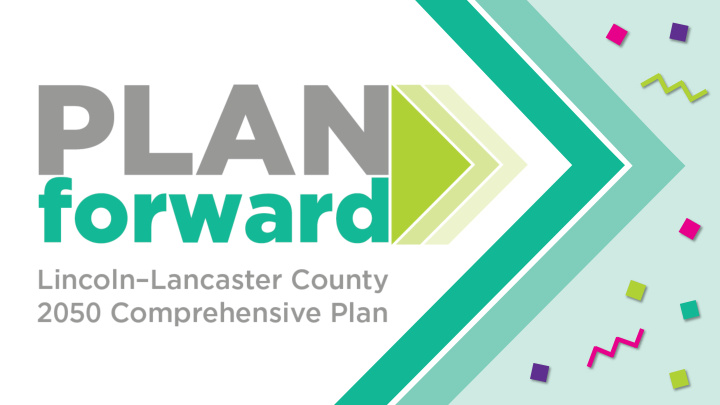



Upcoming Process Today • Reviewing Assumptions from LPlan 2040 • Existing Land Availability • How Much Do We Need to Add? • Where Could Growth Go? Upcoming • Detailed Growth Scenarios for our April Meeting • Growth Scenarios for Public Discussion in May
LPlan Assumptions Today Assumption Actual • Add 1,500 units per year • Added 1,700 units per year, (Lincoln) 2015-2019 • 40 % multi-family • 45 % multi-family • 8,000 infill units, 2016- • 1,906 infill units, 2015-2019 2040 (333 units/year, 22% (381 units/year, 22% of total) of total) • 670 downtown units, 2015- • 3,000 downtown units, 2019 (134 units/year) 2016-2040 (125 units/year) • 3.0 units/acre (edge) • 4.0 units/acre
LPlan Assumptions Today Assumption Updated Assumption • 412,000 by 2040 • 400,000 by 2040 • Lincoln 90% of total • 440,000 by 2050 • Need to add 1,500 • Lincoln 90% of total households per year • Need to add 1,600 households per year
Growth Tiers Map • Tier 1A: developing area with existing approvals • Tier 1B: to be developed by 2026 • Tier 1C: to be developed by 2040 • Tier II: 2040 to 2060 • Tier III: after 2060
Growth Tiers Map • Tier 1A: many areas are now fully developed • Tier 1B: new approvals, currently developing • Stevens Creek trunk line expansion
Looking Forward to 2050 • How much land is currently available in Tier I? • Tier I is the 2040 Future Service Limit established with LPlan 2040 • For current inventory, looking at “developable” land meeting the following criteria: • No existing approvals • Outside floodplain • Not a current acreage site
Looking Forward to 2050 • There are currently 13.4 sq mi of “developable” land within Tier I • 8.1 sq mi of that land is shown as Urban Residential on the Future Land Use Map • The remaining is mostly Industrial and Commercial
Looking Forward to 2050 • How much land must be added to serve our 2050 growth needs? • Let’s look at several growth scenarios • Need to add 47,816 units to Lincoln by 2050 • All options include 16,000 units that are already approved (but not yet developed) within the Future Service Limit • Also includes 10-year cushion to provide flexibility • Only includes residential area • The numbers should still be considered estimates at this point
Growth Scenarios Infill Edge Required Expansion to Density Future Service Limit 1 LPlan Assumptions Continued 22% 3.0 du/acre 9.5 sq mi 2 Recent Trends Continued 22% 4.0 du/acre 5.1 sq mi 3 High Infill, Trend Density 28% 4.0 du/acre 3.6 sq mi 4 High Infill, High Density 28% 5.0 du/acre 1.3 sq mi 5 Trend Infill, Low Density 22% 2.5 du/acre 13.1 sq mi “ALL” Infill (existing edge approvals still included) 6 67% 4.0 du/acre Reduction of 6 sq mi 7 Low Infill, Low Density 16% 2.5 du/acre 15.5 sq mi
Where Could Growth Go?
Plan It Yourself
Plan It Yourself
How Do We Want to Grow? • What are the benefits and challenges of infill? • What are the benefits and challenges of edge growth?
Impacts of Edge Growth vs. Infill • • Edge Infill • • Degraded LFR service Impacts on LFR • Rural school districts Personnel • lose valuation No trail impact fees, but • Impact fees used as may need wider trails • match for new edge trails LPD may need to • Impacts LPD response redistrict based on call- times; Need for more for-service satellite locations • Greater investments in roads (public & private) • Longer commutes
Impacts of Edge Growth vs. Infill • • Edge Infill • • Development pressure Existing floodplain creates impacting floodplains issues • • Expand wastewater Need to preserve parks • collection system School attendance • New LES facilities boundaries • • Increased costs to transit Downtown infill will impact a new Central Library • Upgrade WW in certain locations • New LES facilities • Increased density is good for transit
How Do We Want to Grow? • Are there specific locations that we should prioritize for Future Service Limit expansion?
How Do We Want to Grow? • We will end up with 3-4 scenarios for public review. At this point which three scenarios do you feel are most reasonable to pursue further?
How Do We Want to Grow? • What additional information do you need in order to make informed decisions about the scenarios?
LRTP Update • Primary function of the Lincoln MPO • Updated every 5-years • Blueprint for area’s transportation planning process over the next 30 years • Compliance with federal requirements to receive federal funding • Effort among the City of Lincoln, Lancaster County, the Nebraska Department of Transportation (NDOT), StarTran transit and other agencies • Lincoln MPO's current LRTP was adopted January 13, 2017
Major Work Tasks • Travel Demand Model Update • Current and Future Needs Assessment • Goals, Objectives, and Performance Measures • Alternatives Development and Analysis • Implementation Plan • Documentation • Public Engagement
Public Engagement • Project Website • Press Releases • Meeting Advertisement • Social Media • Email Outreach • Pop-up Events or Public Meetings • Online Meetings • Committees • Focus Groups
LRTP Process
Next Meeting • More details on costs and implications of different growth scenarios • Summary of our public input so far • Additional discussion about the LRTP
Upcoming Events • Public event in May to present growth scenarios and collect feedback (could be “virtual”) • Online survey in May about growth scenarios
Recommend
More recommend